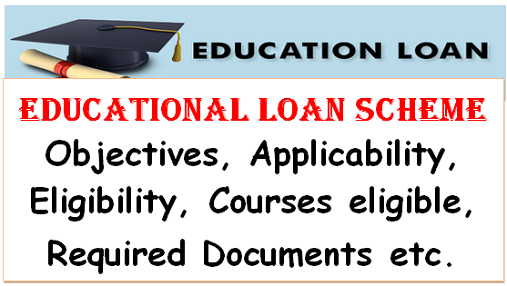Educational Loan Scheme: Objectives, Applicability, Eligibility, Courses eligible, Required Documents etc.
Indian Banks’ Association
MODEL EDUCATIONAL LOAN SCHEME FOR PURSUING HIGHER EDUCATION IN INDIA AND ABROAD 2021
(The scheme provides broad guidelines to the banks for operationalising the Educational loan scheme and the implementing bank will have the discretion to make changes as deemed fit.)
1. INTRODUCTION
Education is central to the human resources development and empowerment in any country. National and State level policies are framed to ensure that this basic need of the population is met through appropriate public and private sector initiatives. While government endeavors to provide primary education to all on a universal basis, public funding of higher education is not considered feasible. Cost of education has been going up in recent times and since the student has to bear most of the cost, there is a clear case for institutional funding in this area. This model education loan scheme is an attempt to bring out a viable and sustainable bank loan scheme to meet the aspirations of our society.
Knowledge and information would be the driving force for economic growth in the coming years. The current rate of economic growth of the country demands technically and professionally trained man power in large numbers. In this backdrop, loans for education are seen as investments for economic development and prosperity. The model Education Loan Scheme was developed by the Indian Banks’ Association to help the meritorious students pursue higher education in India and abroad. As the focus is on development of human capital, repayment of the loan is expected to come from future earnings of the student after completion of education. Hence the assessment of the loan will be based on employability and earning potential of the student upon completion of the course and not the parental income/family wealth.
In 2000, IBA had constituted a Study Group to examine the role of commercial banks in facilitating pursuit of higher education by poor, but meritorious students. This was subsequent to the Finance Minister’s meeting with the Chief Executives of public sector banks.
Based on recommendations made by the Study Group, IBA had prepared a Model Educational Loan Scheme in the year 2001 which has been modified from time to time. The scheme was last modified in the year 2015based on experience gained in the operation of the Scheme over the years.
With increased public awareness about the benefits of the educational loan scheme, bank branches were receiving more and more applications for loans every year. This also resulted in cases of customer grievances due to misinterpretation of the provisions of the scheme. To make the Scheme more transparent in view of customer grievances, and to minimize scope for multiple interpretations leading to disputes, are view exercise was taken up in June 2018.The amendments to the Scheme were approved by the IBA Managing Committee at its meeting held on January 15, 2021.
2. OBJECTIVES OF THE SCHEME
The Educational Loan Scheme outlined below, aims at providing financial support from the banking system to meritorious students for pursuing higher education in India and abroad. The main emphasis is that a meritorious student, though poor, is provided with an opportunity to pursue education with the financial support from the banking system at affordable terms and conditions.
3. APPLICABILITY OF THE SCHEME
The Scheme could be adopted by all member banks of the Association.The scheme provides broad guidelines to the banks for operationalizing the educational loan scheme and implementing banks will have the discretion to make changes as deemed fit.
4.ELIGIBILITY CRITERIA
4.1Nationality
- The student should be an Indian National(including Non-Resident Indian [NRI])
- For Persons of Indian Origin (PIO)/ Overseas Citizens in India (OCI),and students who are born abroad (overseas citizenship by birth, when parents were on deputation with Foreign Government/Government agencies or International / Regional Agencies etc.)and are now studying in India after repatriation of their parents, loans can be considered for studies in India only. However, such facility will be subject to Regulation 7 (C) of Foreign Exchange Management (Borrowing and Lending in Rupees) Regulations, 2000 [Notifications No.FEMA.4/2000-RB dated 3rdMay 2000 and further amended vide Notification No.FEMA.115/2004-RB dated 25thMarch 2004].
(Banks may adopt their Board approved policy for Risk Mitigation)
4.2 Admission
- Should have secured admission to a higher education course in recognized institutions in India or Abroad through Entrance Test/ Merit Based Selection process after completion of HSC(10 plus 2 or equivalent).
- For studies abroad, banks may at their discretion consider granting loans on the basis of invite / conditional offer letter, if demanded by the Educational Institution.
4.3 Meritorious
- If the admission to an eligible course is through a merit based selection process, he/she could be considered a meritorious student.
- If the admission to professional and technical courses is through common entrance test and those who get admission through this process could be considered a meritorious student.
Source: Read more to download the pdf


COMMENTS